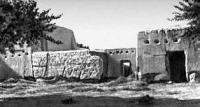You are here
Geok-Gumbez mausoleums.

Tours on archaeological monuments of ancient Merv.
“The main Geok-Gumbez mausoleum reflects keeping local traditional methods in the architecture of XIII - XIV c.c. and, at the same time, emergence of new architectural forms. Some constructional details typical for Merv architecture, for example, method of the tromp construction (like in the mausoleum of Ibn-Zeid and the mosque of Talkhatan-baba) connect it with the foregoing period”
Tourist trip to ancient Merv.
Geok-Gumbez is a deserted place 70 km to the north of Merv where 3 medieval mausolea (XIII-XIV cc.) are situated. They make the ensemble of buildings stretched in line. The largest of them has on the main façade a peshtak with a lancet arch; the other facades are formed by narrow wall niches.
Dome is based on the bay pendentives. Outside, the dome was faced with the blue glazed bricks fallen down later. The second mausoleum has kept only a part of its walls and the portal analogical to the previous one.
The third mausoleum has preserved a small peshtak added to the cube-shaped bulk and a burial vault. In writing sources the Geok-Gumbez ("Blue Dome") is mentioned just in the XV c. in the connection with the events of fight (struggle with, for, against, conflict between) of 1456 between Mirza-Sanjar and Timurid ruler Khusein ibn Mansur ibn Baikara.
In 1951 these monuments (until that time unstudied) were investigated by the Yutake. 3 mausolea in the Geok-Gumbez represent the traditional type of one-chambered portal-and-dome shrine of the Northern Khorasan architectural school.
Here it is possible to trace the process of a new architectural type formation when the centric tomb of XI-XII c.c. gave place to the portal-and-dome mausoleum with emphasized significance of monumental peshtak.
The main Geok-Gumbez mausoleum reflects keeping local traditional methods in the architecture of XIII - XIV c.c. and, at the same time, emergence of new architectural forms. Some constructional details typical for Merv architecture, for example, method of the tromp construction (like in the mausoleum of Ibn-Zeid and the mosque of Talkhatan-baba) connect it with the foregoing period.
The innovation is a strongly developed peshtak which not simply protrudes on main façade (like in the mausoleum of Abu-Said in Mekhne) but represents the principal and sole façade form. The first mausoleum of Geok-Gumbez develops the same theme of one-chambered portal-and-dome shrine which is elaborated in the XIV c. in Mevarenarkh (early group of the mausoleum of Shakhi-Zinda in Samarkand).
Authority:
http://whc.unesco.org







